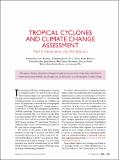| dc.contributor.author | Knutson, Thomas | |
| dc.contributor.author | Camargo, Suzana J. | |
| dc.contributor.author | Chan, Johnny C. L. | |
| dc.contributor.author | Emanuel, Kerry Andrew | |
| dc.contributor.author | Ho, Chang-Hoi | |
| dc.contributor.author | Kossin, James | |
| dc.contributor.author | Mohapatra, Mrutyunjay | |
| dc.contributor.author | Satoh, Masaki | |
| dc.contributor.author | Sugi, Masato | |
| dc.contributor.author | Walsh, Kevin | |
| dc.contributor.author | Wu, Liguang | |
| dc.date.accessioned | 2020-05-29T14:53:33Z | |
| dc.date.available | 2020-05-29T14:53:33Z | |
| dc.date.issued | 2019-10 | |
| dc.identifier.issn | 0003-0007 | |
| dc.identifier.issn | 1520-0477 | |
| dc.identifier.uri | https://hdl.handle.net/1721.1/125577 | |
| dc.description.abstract | An assessment was made of whether detectable changes in tropical cyclone (TC) activity are identifiable in observations and whether any changes can be attributed to anthropogenic climate change. Overall, historical data suggest detectable TC activity changes in some regions associated with TC track changes, while data quality and quantity issues create greater challenges for analyses based on TC intensity and frequency. A number of specific published conclusions (case studies) about possible detectable anthropogenic influence on TCs were assessed using the conventional approach of preferentially avoiding type I errors (i.e., overstating anthropogenic influence or detection). We conclude there is at least low to medium confidence that the observed poleward migration of the latitude of maximum intensity in the western North Pacific is detectable, or highly unusual compared to expected natural variability. Opinion on the author team was divided on whether any observed TC changes demonstrate discernible anthropogenic influence, or whether any other observed changes represent detectable changes. The issue was then reframed by assessing evidence for detectable anthropogenic influence while seeking to reduce the chance of type II errors (i.e., missing or understating anthropogenic influence or detection). For this purpose, we used a much weaker “balance of evidence” criterion for assessment. This leads to a number of more speculative TC detection and/or attribution statements, which we recognize have substantial potential for being false alarms (i.e., overstating anthropogenic influence or detection) but which may be useful for risk assessment. Several examples of these alternative statements, derived using this approach, are presented in the report. | en_US |
| dc.language.iso | en | |
| dc.publisher | American Meteorological Society | en_US |
| dc.relation.isversionof | http://dx.doi.org/10.1175/bams-d-18-0189.1 | en_US |
| dc.rights | Article is made available in accordance with the publisher's policy and may be subject to US copyright law. Please refer to the publisher's site for terms of use. | en_US |
| dc.source | American Meteorological Society | en_US |
| dc.title | Tropical Cyclones and Climate Change Assessment: Part I: Detection and Attribution | en_US |
| dc.type | Article | en_US |
| dc.identifier.citation | Knutson, Thomas et al. "Tropical Cyclones and Climate Change Assessment: Part I: Detection and Attribution." Bulletin of the American Meteorological Society 100, 10 (October 2019): 1987-2008 © 2019 American Meteorological Society | en_US |
| dc.contributor.department | Massachusetts Institute of Technology. Department of Earth, Atmospheric, and Planetary Sciences | en_US |
| dc.relation.journal | Bulletin of the American Meteorological Society | en_US |
| dc.eprint.version | Final published version | en_US |
| dc.type.uri | http://purl.org/eprint/type/JournalArticle | en_US |
| eprint.status | http://purl.org/eprint/status/PeerReviewed | en_US |
| dc.date.updated | 2020-01-15T14:59:53Z | |
| dspace.date.submission | 2020-01-15T14:59:55Z | |
| mit.journal.volume | 100 | en_US |
| mit.journal.issue | 10 | en_US |
| mit.metadata.status | Complete | |
